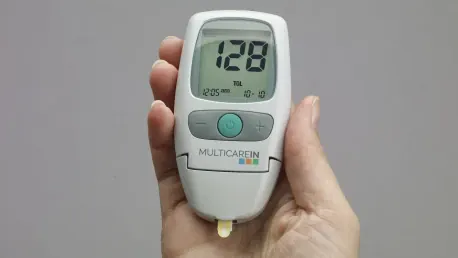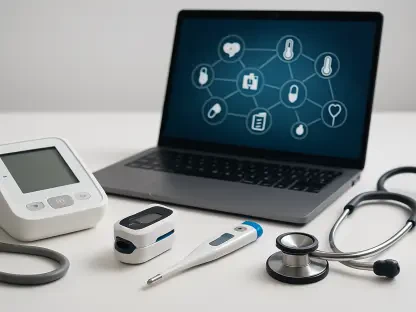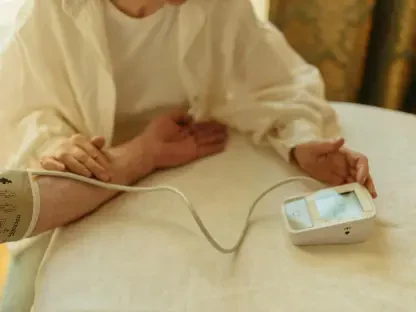The Wearable Medical Devices market is poised for a significant transformation, projected to ascend from USD 40.88 billion in 2023 to an astounding USD 249.97 billion by 2031 at a compounded annual growth rate (CAGR) of 25.40%. This impressive growth trajectory is fueled by an array of factors such as groundbreaking innovations, burgeoning opportunities, elevated health consciousness among consumers, and rapid technological advancements. These devices, which track health metrics and assist in patient care, have become increasingly indispensable in the healthcare sector. This upward trend underscores the immense potential for both established companies and new entrants to leverage emerging opportunities within this thriving market. Consequently, the Wearable Medical Devices market’s evolution is a testament to the seamless integration of technology and healthcare aimed at enhancing the quality of life on a global scale.
Market Segmentation and Its Importance
Understanding the segmentation of the Wearable Medical Devices market is pivotal for grasping its diverse domains and elucidating their individual contributions to overall market expansion. The market is meticulously segmented by product type, site, application, grade type, distribution channel, and region, encompassing diagnostic devices, therapeutic devices, and monitoring devices, among others. These delineations are crucial in highlighting the specific needs and applications inherent in each device type, enabling stakeholders to better comprehend their niches in areas such as sports and fitness, remote patient monitoring, and home healthcare. For example, monitoring devices play a crucial role in chronic disease management, providing real-time data to healthcare providers and enabling timely interventions.
Evaluating the specifics of these segments sheds light on how each category drives market growth. Diagnostic devices, for instance, are integral in the early detection of conditions, aiding significantly in preventive healthcare strategies. Therapeutic devices, on the other hand, cater to ongoing treatment requirements, ensuring that patients receive continuous care. By dissecting the market through these lenses, stakeholders and industry players can devise targeted strategies to better meet consumer demands and optimize their product offerings. Furthermore, this granular understanding of market segmentation facilitates the recognition of emerging trends and growth catalysts unique to each segment, paving the way for informed decision-making and strategic investments.
Competitive Landscape and Key Players
The competitive landscape within the Wearable Medical Devices market is marked by fierce rivalry among key industry players such as Philips Electronics, Fitbit, Garmin, Covidien, and Apple Inc. These companies are at the forefront of the industry, driving innovation, efficiency, and quality. Their relentless pursuit of developing advanced wearable medical devices is underpinned by noteworthy global trends, including the growing demand for environmentally friendly and energy-efficient equipment, the increased use of digital technologies, and adherence to circular economy principles. This competitive intensity necessitates a thorough analysis of these companies to understand their market strategies, production capacities, and financial standings, providing critical insights into the market’s dynamics and future direction.
A pivotal aspect of the competitive landscape is the focus on technological advancements and product innovation, which serve as key differentiators among leading players. Companies like Apple Inc. are continuously enhancing the capabilities of their wearable devices, integrating sophisticated health monitoring features, and ensuring seamless user experiences. Similarly, firms like Fitbit and Garmin are leveraging data analytics and artificial intelligence to offer more personalized health insights and actionable recommendations. This competitive environment not only spurs innovation but also accelerates the adoption of wearable medical devices, enhancing their functionality and user-friendliness. Moreover, understanding the competitive strategies and market positioning of these key players provides valuable benchmarks for new entrants aspiring to carve their niche in this burgeoning market.
Technological Innovations and Market Shifts
Technological innovations and evolving market demands are catalyzing significant shifts within the Wearable Medical Devices market. Devices such as insulin or glucose monitoring devices, sleep monitoring devices, and electrocardiographs have become essential, particularly for managing the rising prevalence of chronic diseases and the necessity of regular health monitoring. Advancements in technology are making these devices more accessible and user-friendly, thereby fostering accelerated customer adoption. The integration of digital technologies and the development of sophisticated sensors stand as monumental contributors to the market’s growth, enhancing the precision, reliability, and user experience of these wearable medical devices. For instance, the advent of non-invasive glucose monitoring technology is poised to revolutionize diabetes management, offering a pain-free alternative to traditional methods.
Moreover, the synergistic combination of wearable devices with mobile applications and cloud-based platforms is revolutionizing healthcare delivery, enabling real-time data analytics and remote patient monitoring. This convergence not only facilitates timely medical interventions but also empowers users to take proactive measures in managing their health. Technological innovations are also propelling the development of multifunctional devices that cater to various health needs, thereby broadening the scope and utility of wearable medical devices. Additionally, these advancements are paving the way for more scalable and cost-effective solutions, making high-quality healthcare more accessible to a broader population. The continuous evolution of these technologies underscores the market’s potential for sustained growth and its pivotal role in modern healthcare ecosystems.
Distribution Channels and Consumer Preferences
Distribution channels exert a profound influence on the dynamics of the Wearable Medical Devices market, with pharmacies, online channels, and hypermarkets playing crucial roles. The exponential rise of e-commerce and the increasing preference for online shopping are transforming online channels into significant points of sale. These platforms provide unparalleled convenience and accessibility, allowing consumers to purchase and utilize wearable medical devices from the comfort of their homes. However, traditional pharmacies remain a steadfast and reliable source, especially for clinical or more specialized wearable medical devices, ensuring that consumers have access to professional guidance and support when needed. The symbiotic relationship between these distribution channels underscores the importance of a multifaceted approach in catering to diverse consumer preferences.
Analyzing consumer behavior reveals a marked shift towards digital platforms, driven by factors such as ease of access, a wide range of product options, and competitive pricing. This trend is particularly significant in the context of the COVID-19 pandemic, which has further accelerated the adoption of online shopping for healthcare products. The convenience and accessibility offered by online platforms are not only enhancing consumer experiences but are also expanding the reach of wearable medical devices to a broader audience. Conversely, the trusted presence of traditional pharmacies plays a critical role for consumers seeking personalized recommendations and immediate purchase options. Balancing these distribution channels is essential for market players aiming to optimize their reach and cater to the evolving needs of their consumer base.
Regional Trends and Growth Prospects
Regional trends play a decisive role in shaping the Wearable Medical Devices market, with various regions exhibiting distinct growth patterns and opportunities. North America and Europe are at the vanguard, propelled by higher healthcare expenditures, advanced healthcare infrastructure, and aging populations requiring continuous health monitoring. These regions are characterized by a high penetration rate of wearable medical devices, driven by robust healthcare systems and proactive health management practices. Additionally, supportive regulatory frameworks and reimbursement policies further bolster the market’s growth in these regions, ensuring a conducive environment for innovation and adoption. However, the Asia-Pacific region is anticipated to witness the highest growth rate, attributed to escalating health awareness, increasing disposable incomes, and rising incidences of chronic diseases.
Countries within Asia-Pacific are investing significantly in healthcare infrastructure, fostering a favorable market landscape for wearable medical devices. Technological advancements and the proliferation of smartphones are further enhancing the adoption of wearable devices in this region. Similarly, the Middle East, Africa, and Latin America are also catching up, buoyed by increased investments in healthcare infrastructures and rising consumer awareness about the benefits of wearable medical devices. These regional trends underscore the diverse growth opportunities and challenges faced by the market across different geographical landscapes. The global sweep of wearable medical devices highlights the need for region-specific strategies to tap into the unique growth prospects each region offers, ensuring a well-rounded market expansion.
Socio-Economic Impact of Wearable Medical Devices
The socio-economic impact of wearable medical devices transcends mere health monitoring, playing a transformative role in preventive healthcare. These devices facilitate early diagnosis, continuous monitoring, and timely medical interventions, thereby potentially alleviating the burden on healthcare systems. As the global population ages, the demand for healthcare solutions that provide personalized and remote care escalates, and wearable medical devices bridge this gap effectively. By enabling continuous monitoring and management of health conditions outside traditional healthcare settings, these devices offer a promising solution for an increasingly strained healthcare infrastructure. The data generated by these devices can be pivotal in predicting and managing health trends, contributing to more efficient healthcare management.
Beyond individual health benefits, wearable medical devices have broader socio-economic implications. They empower individuals with real-time health data, fostering a proactive approach to personal health management. This proactive stance can lead to early detection of potential health issues and prompt medical consultations, reducing the incidence of severe health complications and associated treatment costs. Moreover, the healthcare data collected through these devices can contribute to large-scale health studies and research, offering valuable insights into population health trends and enabling more targeted public health interventions. The socio-economic impact of wearable medical devices thus underscores their integral role in modern healthcare, promising improved health outcomes and more sustainable healthcare systems.
Market Challenges and Regulatory Compliance
The Wearable Medical Devices market is highly competitive, with key players like Philips Electronics, Fitbit, Garmin, Covidien, and Apple Inc. These industry giants lead the way in innovation, efficiency, and quality. They are constantly developing advanced wearable medical devices, driven by global trends such as the demand for eco-friendly, energy-efficient equipment, increased use of digital technologies, and circular economy principles. This competition requires a detailed analysis of their strategies, production capabilities, and financial health to grasp the market’s dynamics and future direction.
A crucial aspect of this competitive landscape is the emphasis on technological advancements and product innovation. Companies like Apple Inc. are enhancing their wearable devices with advanced health monitoring features and ensuring seamless user experiences. Firms like Fitbit and Garmin use data analytics and artificial intelligence to provide personalized health insights and actionable recommendations. This competitive environment not only drives innovation but also speeds up the adoption of wearable medical devices, improving their functionality and user-friendliness. Understanding these companies’ competitive strategies and market positioning offers valuable insights for new entrants aiming to establish themselves in this growing market.









